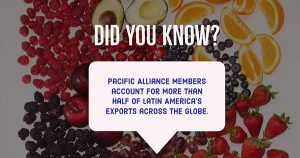In addition to Americans’ healthy appetites, free trade or trade promotion agreements have helped accelerate the growth of business between the north and south. Many Latin American countries participate in some kind of trade agreement with the United States.


Chile signed a free trade agreement with the United States in 2003 guaranteeing that, as of Jan. 1, 2004, tariffs on 90 percent of U.S. exports to Chile and 95 percent of Chilean imports would disappear.
Not to be left behind, Guatemala, Costa Rica, Honduras, El Salvador, and Nicaragua signed on to the Central American Free Trade Agreement with the United States in 2004, and the Dominican Republic joined in 2009. The agreement eliminated tariffs and fees on trade between its members. Peru, Panama, and Colombia also have their own trade promotion agreements.
Negotiating free trade agreements with the United States can be a tricky business. For starters, there are specific requirements depending on product. Guatemalan mangoes, for example, require hot water treatment to kill pests before they can be exported to the United States.
There also have to be certified U.S. Department of Agriculture inspectors present in mango packing sheds to ensure the process is being followed. By the same token, papaya produced in the northern part of the country doesn’t require treatment, while fruit grown in the south of Guatemala are more susceptible to Mediterranean fruit flies, or medflies, and must undergo hot water treatment before being considered for export.
“With any other produce we want to export to the U.S. market, we have to comply with whatever the USDA has approved in terms of quantities of fertilizer and chemicals for production of the produce,” says Dunia Miranda-Mauri of the Guatemala Trade and Investment Office in Miami.
“There’s a long list of products we can’t export to the United States. And in some cases, similar to avocados, we’ve been working on the protocols for many years,” Miranda-Mauri says. “It took Mexico many decades to be able to bring avocados to the United States because California was the biggest grower of avocados, and they were protecting their industry.”
In addition to the many trade and promotional agreements, the big one among the three continental giants – United States, Mexico and Canada – will change some terms with the United States- Mexico-Canada Agreement (USMCA) replacing the former agreement, NAFTA.
USMCA was officially agreed to by the three nations Sept. 30.
Great Britain has expressed interest in a free trade agreement with Chile, and has pursued meetings with the Pacific Alliance, a trading bloc formed in 2011 that includes Colombia, Mexico, Peru, and Chile. Pacific Alliance members boast a combined GDP of $2 trillion and account for more than half of Latin America’s exports across the globe.
This is an excerpt from the most recent Produce Blueprints quarterly journal. Click here to read the full article.


